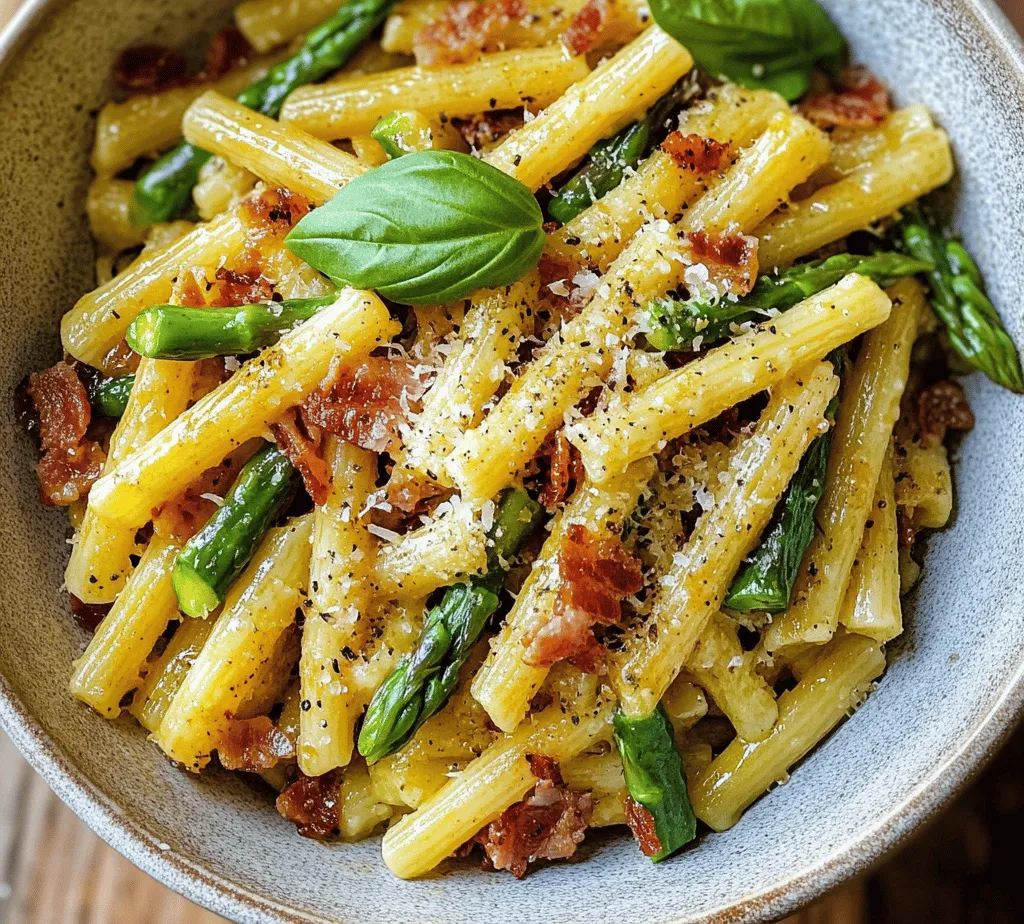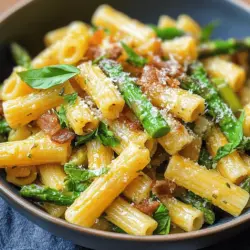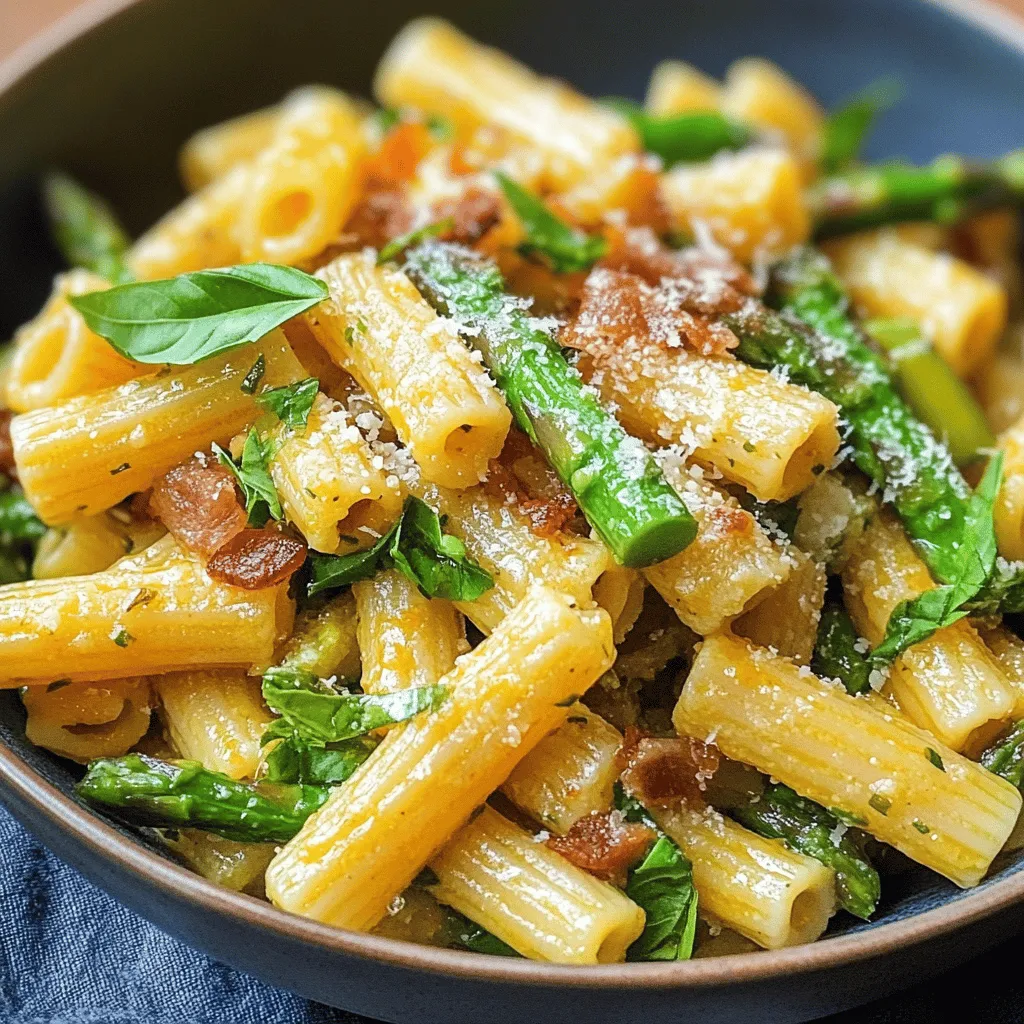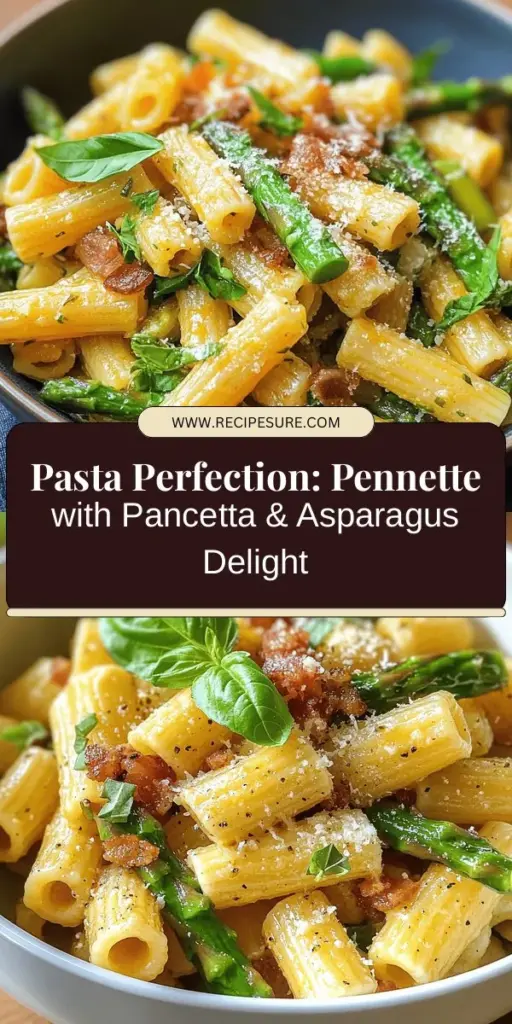Introduction
Exploring the world of pasta can be a delightful culinary adventure, and few dishes embrace this spirit as vibrantly as Pennette Pasta Adventure with Pancetta and Asparagus. This recipe combines the rich flavors of crispy pancetta with the fresh, vibrant notes of asparagus, creating a harmonious blend that is both satisfying and sophisticated. The combination of these ingredients not only tantalizes the taste buds but also brings an elegant touch to your dining table, making it suitable for both casual family dinners and more formal gatherings.
Pasta has a storied history that dates back centuries, with its roots traced to the Mediterranean region. Among the many varieties, pennette pasta stands out due to its unique shape and versatility. The small, tube-like structure of pennette allows it to hold onto sauces beautifully, ensuring that each bite is imbued with flavor. In this article, we will delve into the origins of pennette pasta, explore the role of each ingredient in this delectable recipe, and provide a step-by-step process for creating this mouthwatering dish. By the end, you’ll not only know how to prepare it but also appreciate the culinary artistry behind this recipe.
Understanding Pennette Pasta
The Unique Characteristics of Pennette Pasta
So, what exactly is pennette pasta? Pennette, which translates to “little pens” in Italian, is a small, tubular pasta that is similar to penne but shorter. Its distinctive shape is perfect for capturing sauces, making it a favorite in many Italian households. Typically, pennette is made from durum wheat semolina, which gives it a firm texture that holds up well during cooking and allows it to pair nicely with a variety of ingredients.
One of the defining characteristics of pennette is its slightly angled ends, which not only enhance its visual appeal but also create a delightful mouthfeel. When cooked, this pasta offers a satisfying bite that complements the other components of the dish. Whether tossed in a creamy sauce, baked with cheese, or served simply with olive oil and garlic, pennette is a versatile choice that is sure to impress.
Exploring the Texture and Shape of Pennette
Pennette’s small size and tubular shape provide an excellent canvas for sauces and toppings. Similar to rigatoni or ziti, its ridges can capture bits of pancetta and asparagus, ensuring that every forkful is packed with flavor. The texture of cooked pennette is al dente, which means it retains a slight firmness when bitten. This quality not only enhances the overall experience but also helps the pasta maintain its shape during the cooking process, preventing it from becoming mushy.
How Pennette Differs from Other Pasta Varieties
While there are countless varieties of pasta available, pennette sets itself apart in both its size and its cooking versatility. Unlike long pasta types such as spaghetti or fettuccine, pennette can be enjoyed in a variety of formats, from salads to baked dishes. Its short length makes it particularly appealing for hearty, saucy recipes like our Pennette Pasta Adventure with Pancetta and Asparagus, as it allows for easy incorporation of chunky ingredients. Unlike smoother pasta varieties, pennette’s ridges and tubular shape create a delightful texture that enhances the overall mouthfeel of the dish.
The Role of Ingredients in the Recipe
Highlighting Pancetta: The Flavorful Backbone
At the heart of this dish lies pancetta, an Italian cured meat that adds depth and richness. Made from pork belly, pancetta is typically seasoned with a mix of spices, salt, and herbs, then rolled and cured. Unlike bacon, which is smoked, pancetta is unsmoked and offers a more subtle flavor profile, making it an ideal choice for this recipe. When cooked, pancetta becomes crispy, releasing its savory oils that contribute to the overall flavor of the dish.
The rendered fat from the pancetta infuses the pasta and vegetables with a deliciously rich taste, elevating the entire dish. It acts as the flavor backbone, harmonizing with the fresh notes of asparagus and the sharpness of garlic and parmesan. With each bite, the crispy pancetta provides a satisfying crunch that beautifully contrasts the tender pasta and vegetables.
A Closer Look at Asparagus: Nutritional Benefits and Flavor Profile
Asparagus is not only a delicious addition to this dish but also a powerhouse of nutrition. This green vegetable is low in calories but high in vitamins A, C, E, and K, making it a healthy choice for any meal. Asparagus is also a good source of fiber, helping to promote digestive health.
In terms of flavor, asparagus has a delicate, slightly sweet taste that pairs wonderfully with the savory pancetta. When cooked just right, it retains a bright green color and a tender-crisp texture that enhances the visual appeal of the dish. The vibrant green hue of the asparagus adds a fresh element to the plate, making it more inviting and appetizing.
The Importance of Garlic and Parmesan in Enhancing Taste
Garlic is a staple ingredient in Italian cooking, known for its bold flavor and health benefits. In this recipe, it adds a fragrant aroma and a robust taste that complements the pancetta and asparagus. The key is to sauté the garlic until it is fragrant but not browned, as burnt garlic can impart a bitter flavor to the dish.
Parmesan cheese plays a crucial role in elevating the overall flavor profile. Its nutty, salty taste balances the richness of the pancetta and the freshness of the asparagus. When freshly grated and added at the end of the cooking process, it melts slightly, creating a creamy coating that clings to the pasta. This addition not only enhances the dish’s flavor but also adds a luxurious mouthfeel.
Choosing the Right Olive Oil: Quality Matters
When it comes to cooking, the type of olive oil you use can significantly impact the flavor of your dish. For this recipe, opt for a high-quality extra virgin olive oil, known for its rich flavor and health benefits. Extra virgin olive oil is made from the first cold pressing of olives, which preserves the natural flavors and nutrients. It’s perfect for sautéing the pancetta and garlic, as well as drizzling over the finished dish for an extra touch of richness.
Optional Ingredients: The Role of Lemon Juice and Basil
While the core ingredients of this recipe create a deliciously balanced dish, there are optional additions that can elevate the flavors even further. A squeeze of lemon juice adds brightness and acidity, enhancing the overall taste profile and cutting through the richness of the pancetta. Fresh basil, on the other hand, adds an aromatic quality that complements the dish beautifully. Both ingredients can be added at the end of the cooking process to preserve their vibrant flavors.
Step-by-Step Guide to Preparing Pennette Pasta Adventure
Cooking the Pasta to Perfection
Now that we’ve explored the ingredients and their roles, let’s dive into the preparation process. The first step in creating the Pennette Pasta Adventure with Pancetta and Asparagus is to cook the pasta. Begin by bringing a large pot of salted water to a rolling boil. The salt not only seasons the pasta but also enhances its flavor.
Once the water is boiling, add the pennette and cook according to the package instructions, usually around 10-12 minutes, until al dente. It is essential to taste the pasta a minute or two before the suggested cooking time to ensure it reaches the desired texture. Al dente pasta should be firm to the bite but not hard.
Tips for Achieving Al Dente Texture
To achieve the perfect al dente texture, consider the following tips:
1. Use a large pot with plenty of water to prevent the pasta from sticking together.
2. Stir the pasta occasionally during cooking to ensure even cooking.
3. Reserve a cup of pasta water before draining. This starchy water will be useful later for adjusting the sauce’s consistency.
Why Reserving Pasta Water is Essential
Reserving pasta water is a crucial step in many pasta recipes, including this one. The starchy water can be used to loosen the sauce, create a silky texture, and help all the flavors meld together. After draining the pasta, set aside a cup of the cooking water before discarding the rest.
Sautéing Pancetta: Techniques for Crispy Texture
While the pasta cooks, it’s time to focus on the pancetta. In a large skillet, heat a drizzle of olive oil over medium heat. Once hot, add the diced pancetta. Sauté the pancetta for about 5-7 minutes, stirring occasionally, until it becomes crispy and golden. The goal is to render the fat and achieve a delightful crunch without burning it.
Understanding the Rendered Fat: Flavor Booster
As the pancetta cooks, it will release its flavorful fat into the skillet. This rendered fat is a flavor powerhouse, providing depth and richness to the dish. Be sure to scrape any brown bits that form on the bottom of the skillet, as these contribute to the overall flavor of the sauce.
Preparing Asparagus: Keeping it Tender and Vibrant
While the pancetta is cooking, it’s time to prepare the asparagus. Start by trimming the tough ends of the asparagus stalks, then cut them into bite-sized pieces. You want the asparagus to be tender but still vibrant in color, which means cooking it for just a few minutes.
Add the asparagus to the skillet with the pancetta after it has been cooking for about 3 minutes. Sauté the mixture for an additional 3-4 minutes, until the asparagus is bright green and just tender. Be cautious not to overcook the asparagus, as it should retain some crunch and freshness.
Timing and Techniques for Perfectly Cooked Asparagus
To ensure perfectly cooked asparagus, consider the following techniques:
- Use a lid to cover the skillet for the last minute of cooking. This helps steam the asparagus slightly, ensuring it cooks through without losing its vibrant color.
- Avoid overcrowding the skillet; if necessary, cook the pancetta and asparagus in batches to achieve the best texture.
Combining Ingredients for a Flavorful Dish
Once the pennette has reached al dente texture, drain it and add it directly to the skillet with the pancetta and asparagus. Toss everything together over low heat, allowing the flavors to meld. If the mixture seems dry, gradually add reserved pasta water until you reach the desired consistency.
Incorporate the minced garlic and let it sauté for about 30 seconds, just until fragrant. Finally, stir in the freshly grated Parmesan cheese, allowing it to melt and coat the pasta evenly. If desired, squeeze a bit of lemon juice and add fresh basil for an extra burst of flavor.
Now that you have all the foundational elements in place, you’re well on your way to creating a memorable Pennette Pasta Adventure with Pancetta and Asparagus. With each step, you’ll discover the beauty of combining simple ingredients into a sophisticated dish that highlights the best of Italian cuisine. Stay tuned for the next part, where we’ll explore additional tips and variations to enhance your culinary experience.

How to Properly Toss Pasta with Ingredients
Once your pennette pasta is cooked al dente, it’s time to bring it together with the other ingredients. The key to a well-combined pasta dish is proper tossing. Start by adding the cooked pasta directly to the skillet with the pancetta and asparagus. Use tongs or a pasta fork to gently lift and turn the pasta, ensuring the pancetta and asparagus are evenly distributed throughout. This gentle tossing method prevents the pasta from breaking while allowing the flavors to meld seamlessly.
If needed, you can add a splash of the reserved pasta water to help the ingredients stick together. This method not only combines the flavors but also allows the pasta to absorb some of the essence of the pancetta and asparagus, enhancing the overall taste of the dish.
Adjusting Consistency with Pasta Water
Pasta water is a crucial component when it comes to achieving the perfect consistency for your dish. As you toss the pasta with the pancetta and asparagus, keep an eye on the overall texture. If the pasta seems too dry, gradually add a tablespoon of the reserved pasta water. This starchy water will help bind the sauce to the pasta and create a silkier texture without making it too soupy. The goal is to achieve a harmonious balance where the pasta is coated, but not swimming in liquid.
Incorporating Parmesan: Creating a Creamy Finish
To elevate your Pennette Pasta Adventure, integrating freshly grated Parmesan cheese is a game-changer. Once you’ve achieved the desired consistency, sprinkle a generous amount of Parmesan over the pasta. As you toss the pasta, the cheese will melt slightly, creating a creamy coating that clings to each pennette. This addition not only enhances the richness of the dish but also adds a depth of umami flavor that complements the pancetta beautifully.
Why Seasoning is Key: Balancing Salt and Pepper
Seasoning is an essential aspect of cooking that can make or break your dish. As you mix in the Parmesan, taste your pasta and adjust the seasoning as necessary. A pinch of salt and fresh ground black pepper can bring the flavors to life. Remember, pancetta is naturally salty, so be cautious not to overdo it. The goal is to enhance the existing flavors without overshadowing them. A well-seasoned dish will have a delightful balance that keeps each bite interesting.
The Refreshing Touch of Lemon Juice
To finish your pasta dish and elevate it to new heights, consider adding a splash of fresh lemon juice. The acidity of the lemon will cut through the richness of the pancetta and cheese, providing a refreshing counterbalance. Squeeze half a lemon over the pasta just before serving, and toss again to ensure the citrus flavor is evenly distributed. This bright touch will invigorate the dish, making it feel light and fresh.
Plating and Presentation Tips
The Art of Plating: Making Your Dish Visually Appealing
When it comes to serving your Pennette Pasta Adventure, presentation is key. Start by twirling a generous portion of pasta onto a warm plate. Use a fork or tongs to create a nice mound in the center, allowing the pasta to fall gracefully. This technique not only looks appealing but also invites diners to dig in.
For added visual appeal, consider layering ingredients. Place some sautéed asparagus and crispy pancetta on top of the pasta mound. This strategic arrangement showcases the dish’s key components and makes it more inviting.
Garnishing with Fresh Basil: A Pop of Color and Flavor
To finish your plating, add a pop of color with fresh basil leaves. Scatter a few torn basil leaves over the dish, or place one on top for a simple yet elegant touch. The aromatic quality of basil complements the flavors of the dish, enhancing the overall presentation and taste.
Nutritional Analysis of Pennette Pasta Adventure
Caloric Breakdown of the Dish
Understanding the nutritional value of your cooking is important, especially when trying to maintain a balanced diet. A serving of Pennette Pasta Adventure with Pancetta and Asparagus typically contains around 450-550 calories, depending on the portion size and the amount of cheese used. The carbohydrates from the pasta provide energy, while the pancetta contributes protein and healthy fats.
Health Benefits of Ingredients Used
This dish not only tantalizes the taste buds but also offers several health benefits. Asparagus is packed with vitamins A, C, E, and K, as well as fiber, which promotes digestive health. The use of whole grain pennette can provide additional fiber and essential nutrients compared to regular pasta. Pancetta, though higher in fat, contains protein and can be enjoyed in moderation as part of a balanced meal.
How to Make the Dish Healthier Without Sacrificing Flavor
If you’re looking to lighten up the dish without sacrificing flavor, consider a few simple substitutions. Opt for whole grain or legume-based pasta for added fiber and protein. You can also reduce the amount of pancetta and instead add more vegetables, such as cherry tomatoes or spinach, to increase the nutritional content. Replacing some of the Parmesan with a lower-fat cheese can also help cut calories while maintaining that creamy finish.
Culinary Pairings and Serving Suggestions
Wine Pairings: Perfect Matches for Your Pasta Dish
Selecting the right wine can enhance your dining experience. A crisp white wine such as Pinot Grigio or Sauvignon Blanc pairs beautifully with the creamy and savory notes of the Pennette Pasta Adventure. These wines complement the dish’s flavors without overpowering them. For those who prefer red, a light Chianti or a Pinot Noir can also work well, providing a nice balance with the richness of the pancetta.
Side Dishes to Complement Pennette Pasta
To round out your meal, consider serving a light side salad with fresh greens, cherry tomatoes, and a simple lemon vinaigrette. This refreshing accompaniment will balance the richness of the pasta. Garlic bread or bruschetta can also be delightful side options, providing a satisfying crunch that pairs well with the creamy pasta.
Incorporating Seasonal Variations: Adapting the Recipe Throughout the Year
One of the beauties of pasta dishes is their adaptability to seasonal ingredients. In spring and summer, you can incorporate fresh vegetables like zucchini or peas for a lighter take. In the fall and winter, consider adding roasted butternut squash or mushrooms for a heartier version. This flexibility allows you to enjoy your Pennette Pasta Adventure year-round, adjusting flavors to match the seasons.
Cultural Context and Variations of Pasta Dishes
The Italian Influence on Pasta Dishes
Pasta is an integral part of Italian cuisine, celebrated for its versatility and ability to pair with a wide range of flavors. The use of ingredients like pancetta and asparagus in this recipe reflects the traditional Italian practice of balancing rich and fresh elements, creating a dish that is both satisfying and vibrant.
Regional Variations of Pasta with Pancetta
In Italy, pancetta is often featured in various regional dishes. For instance, in the Lazio region, pasta alla Gricia showcases the beauty of guanciale (cured pork cheek) paired with sheep’s cheese. Each variation highlights local ingredients, showcasing the diversity of Italian cooking while maintaining the essence of pasta as a beloved staple.
Exploring Global Takes on Similar Recipes
Pasta dishes are not limited to Italian cuisine; they have inspired global adaptations. For example, in Asian cuisine, you might find stir-fried noodle dishes featuring similar ingredients, such as pancetta or bacon, combined with seasonal vegetables. Exploring these variations can provide a fresh perspective on your Pennette Pasta Adventure, revealing the universal love for pasta across cultures.
Conclusion
Pennette Pasta Adventure with Pancetta and Asparagus is more than just a meal; it’s a celebration of flavors, textures, and culinary traditions. By mastering this dish, you not only enhance your cooking skills but also deepen your appreciation for the art of pasta-making. Whether you’re preparing it for a special occasion or a cozy weeknight dinner, this recipe is sure to impress and satisfy. Embrace the adventure in your kitchen, and let each bite transport you to the heart of Italian gastronomy. The journey through this delightful dish will not only delight your taste buds but also inspire a greater love for cooking and sharing meals with loved ones.


